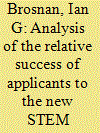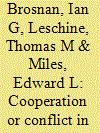| Srl | Item |
| 1 |
ID:
142590


|
|
|
|
|
| Summary/Abstract |
In 2014, the U.S. Office of Personnel Management's Presidential Management Fellowship (PMF) Program initiated a pilot, PMF STEM, to bring recent graduates with advanced degrees in science, technology, engineering, and mathematics (STEM) fields into federal service. The NASA Office of Human Capital was closely engaged, and the pilot was a welcome new avenue for STEM hiring. Here, I ask how the Finalists in this new STEM program fared relative to traditional PMF finalists. I find that the rates at which traditional PMF and PMF STEM Finalists in the Class of 2014 received their first appointment offers were significantly different (p = 0.0315), and PMF STEM Finalists were initially offered appointments at higher rates than the PMF Finalists. However, this advantage disappeared over time, possibly because the remaining PMF STEM Finalists were not a good fit to the available STEM opportunities. When the appointment period for the Class of 2014 closed, 58% of PMF STEM Finalists and 72% of PMF Finalists had received appointment offers. Although a smaller proportion of PMF STEM Finalists received offers in 2014, their offer rate was consistent with the long-term average. I briefly discuss the NASA context for these results.
|
|
|
|
|
|
|
|
|
|
|
|
|
|
|
|
| 2 |
ID:
104179


|
|
|
|
|
| Publication |
2011.
|
| Summary/Abstract |
The possibility of conflict among nations has dominated discussions of the future of the Arctic. Are there no opportunities for cooperation? This article explores the avenues and incentives for Arctic cooperation through the common issues outlined in the strategy statements of the five coastal Arctic states. Incentives to cooperate can be found in all the thematic areas examined: sovereignty, scientific research, resource development, shipping, and environmental concerns. Cooperation is already occurring on some salient issues. Additional cooperation may occur as issues become increasingly pressing. From this perspective, Arctic conflict is by no means inevitable. Numerous avenues for cooperation exist.
|
|
|
|
|
|
|
|
|
|
|
|
|
|
|
|